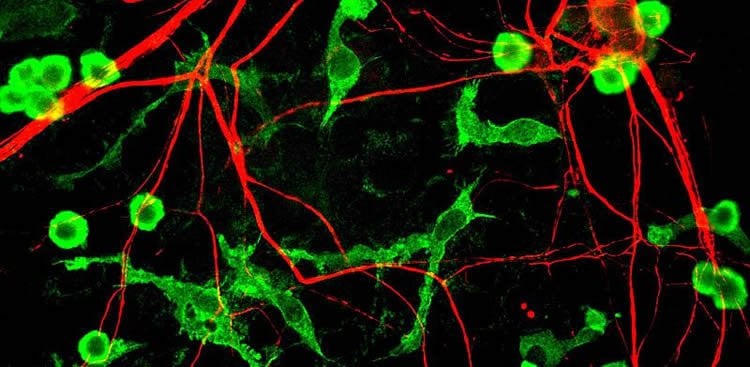Summary: Researchers confirm microglia, immune cells implicated in neurodegenerative disorders, play a role in protecting the central nervous system.
Source: University of Virginia.
Immune cells commonly blamed in Alzheimer’s and other neurodegenerative diseases are actually precision cleaning machines protecting the central nervous system, new research from the University of Virginia School of Medicine shows.
The discovery adds nuance and complexity to our understanding of immune cells known as microglia. By appreciating the role of these cells in full, scientists are better positioned to develop new treatments and tailor medicine to individual patients’ needs.
“What we’re finding now is that at very acute time points, whether it’s in disease or whether it’s injury, the microglia are doing a lot,” said researcher Geoffrey Norris, PhD. “It’s important to know the role and function of these cells, especially going forward for human therapy.”
Understanding Microglia
Norris and colleagues in UVA’s Department of Neuroscience and its Center for Brain Immunology and Glia (BIG) developed a new model that lets them study microglia in the context of acute injury. Researchers already knew that the cells play a critical role in brain development, but their role in adulthood was much murkier, with many scientists arguing their activity was harmful. UVA’s research reveals that injury to the central nervous system activates the microglia, and the cells respond with remarkable precision. “It seems that microglia are very responsive to the job at hand,” Norris said. “So rather than being good or bad, what we’re basically seeing is that they’re doing what they need to do.”
He compared the cells to a construction crew knocking down a damaged building. “If you have a crumbling building after a house fire, you usually take the building away, right? You load it up on dump trucks and take it away,” he said. “That’s what the microglia are doing with this debris.”
The research doesn’t rule out the possibility that the microglia could be too aggressive in their debris removal, or perhaps something could go wrong during removal and contribute to disease. To continue the house analogy, maybe the demolition crew is knocking down a slightly damaged kitchen rather than simply repairing it. “Whether the microglia activity is detrimental or not is really just starting to be teased out,” Norris said.
Fast Acting, Deep Cleaning
UVA’s new model allowed the researchers to observe as the cells swallowed up damaged material while leaving healthy cells untouched – strikes surgical in their precision. “If you look just a couple of microns away, their neighboring microglia are basically unresponsive,” Norris said. “So it’s a very contained area of activation, which was very interesting to us.”

The researchers also noted how quickly the cells were changing and how quickly they cleared debris. Scientists working on treatments for neurological diseases may need to factor that in. Depending on the progression of a disease such as Alzheimer’s or Parkinson’s, “it might be that the microglia have already done a lot of work and you would need another approach,” Norris said.
‘A New Generation of Therapeutic Agents’
Jonathan Kipnis, PhD, chairman of UVA’s Department of Neuroscience and director of the BIG Center, predicted the new understanding of microglia will have important ramifications.
“Microglia were the neglected cells of the brain for decades,” Kipnis said. “The tide is changing, and we now realize how interesting and unique the biology of these cells is. This work shows the physiological response of microglia after CNS [central nervous system] injury, which is very different from their role in neurodevelopment or in chronic pathologies, such as Alzheimer’s disease. Understanding microglia biology in physiology and pathology will bring us closer to development of a new generation of therapeutic agents for neurological disorders.”
Funding: The work was supported by the National Institutes of Health, grants MH096484 and NS096967..
Source: Josh Barney – University of Virginia
Publisher: Organized by NeuroscienceNews.com.
Image Source: NeuroscienceNews.com image is for illustrative purposes only.
Original Research: Open access research “Neuronal integrity and complement control synaptic material clearance by microglia after CNS injury” by Geoffrey T. Norris, Igor Smirnov, Anthony J. Filiano, Hannah M. Shadowen, Kris R. Cody, Jeremy A. Thompson, Tajie H. Harris, Alban Gaultier, Christopher C. Overall, Jonathan Kipnis in Journal of Experimental Medicine. Published June 25 2018.
doi:10.1084/jem.20172244
[cbtabs][cbtab title=”MLA”]University of Virginia”True Nature of Cells Blamed in Alzheimer’s Revealed.” NeuroscienceNews. NeuroscienceNews, 26 June 2018.
<https://neurosciencenews.com/microglia-role-9450/>.[/cbtab][cbtab title=”APA”]University of Virginia(2018, June 26). True Nature of Cells Blamed in Alzheimer’s Revealed. NeuroscienceNews. Retrieved June 26, 2018 from https://neurosciencenews.com/microglia-role-9450/[/cbtab][cbtab title=”Chicago”]University of Virginia”True Nature of Cells Blamed in Alzheimer’s Revealed.” https://neurosciencenews.com/microglia-role-9450/ (accessed June 26, 2018).[/cbtab][/cbtabs]
Abstract
Neuronal integrity and complement control synaptic material clearance by microglia after CNS injury
Phagocytosis of synaptic material by microglia is critical for central nervous system development. Less well understood is this microglial function in the injured adult brain. Assay of microglial phagocytosis is challenging, because peripheral myeloid cells engraft the site of injury, which could obscure interpretation of microglial roles. The model used here, optic nerve crush injury, results in degeneration of synapses in the dorsal lateral geniculate nucleus (dLGN), which stimulates rapid activation and engulfment of synaptic material by resident microglia without myeloid cell engraftment. Pharmacological depletion of microglia causes postinjury accumulation of synaptic debris, suggesting that microglia are the dominant postinjury phagocytes. Genetic or pharmacological manipulations revealed that neuronal activity does not trigger microglia phagocytosis after injury. RNA sequencing reveals C1q and CD11b/CR3 involvement in clearance of debris by dLGN-resident microglia. Indeed, C1qa−/− and Itgam−/− mice exhibit impaired postinjury debris clearance. Our results show how neurodegenerative debris is cleared by microglia and offers a model for studying its mechanisms and physiological roles.






